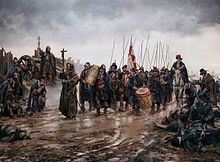 | ||
Similar Dutch Revolt, Battle of Haarlemmermeer, Battle of Jemmingen, Battle of Oosterweel, Battle of Rijmenam | ||
The Battle of Empel or Miracle of Empel (Milagro de Empel in Spanish) was a battle fought on December 7 and December 8, 1585 near Empel, in the Netherlands, as part of the Eighty Years' War, in which a Spanish force miraculously achieved victory in very adverse conditions. In Spain the battle is still remembered as it is believed that the army was saved due to intervention of Mary of the Immaculate Conception.
Contents
The Battle
After the campaign of 1585, the Governor of Spanish Netherlands and commander of the Spanish troops Alexander Farnese, Duke of Parma decided to go into winter quarters on Northern Dutch territory. The troops of Karl von Mansfeld occupied the area around 's-Hertogenbosch. Some 3000-4000 men of the Spanish Tercio, including Juan del Águila, under Maestre de Campo Francisco de Bobadilla were stationed on Bommelerwaard, which was supposed to be rich enough to support these troops through the winter. But all farmers had left the island, taking their livestock with them.
To make the situation of the hungry Spanish troops even worse, Dutch commander Philip of Hohenlohe-Neuenstein arrived with a strong land force and 100 ships. The Dutch leader offered an honorable surrender to the Spaniards but the response was resolute: «Los infantes españoles prefieren la muerte a la deshonra. Ya hablaremos de capitulación después de muertos.» (English: "Spanish soldiers prefer death to dishonor. We will talk about surrender after death"). Philip of Hohenlohe-Neuenstein breached the dikes of Bommelwaard, forcing the Spanish back over the Rhine to Empel. There they were unable to reach 's-Hertogenbosch, because the terrain was flooded and guarded by the fleet of Hohenlohe. The island was attacked as well by artillery fire coming from a fort, at the other side of the river.
The situation for the Spanish looked desperate. A Spanish soldier who was digging a trench around the church commented "this is more likely to be my grave than a trench". As he dug, he found a painting representing Mary of the Immaculate Conception. Bobadilla interpreted the discovery as a sign from God, and had the painting put on the Spanish flag for worship.
That night, an unusual and completely intensely cold wind that chilled the waters of the River Meuse broke. The Dutch ships had to be withdrawn to prevent them being stuck in the ice. This made it possible for the remaining Spanish troops to escape to the safety of 's-Hertogenbosch. Admiral Hohenlohe-Neuenstein went on to say: "It seems that God is Spanish to work for me so great miracle ".
That same day, Mary of the Immaculate Conception was proclaimed patroness of the Spanish Tercios of Flanders and Italy.
In the 19th century
On December 8, 1854, Pope Pius IX defined the dogma of the Immaculate Conception of the Blessed Virgin Mary; In 1892, Maria Cristina of Austria (Maria Christina Désirée Henriette Felicitas Rainiera von Habsburg-Lothringen, und Österreich), Queen Regent of Spain, proclaimed Mary of the Immaculate Conception patroness of the entire Spanish Infantry.
